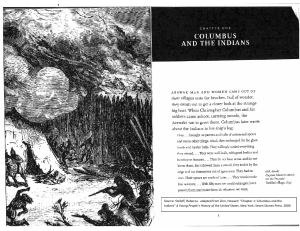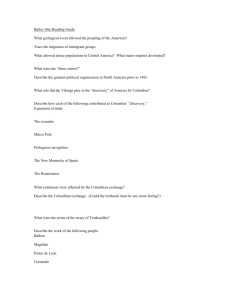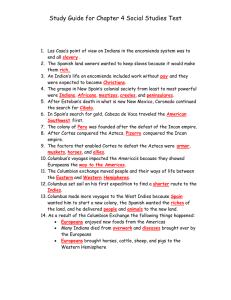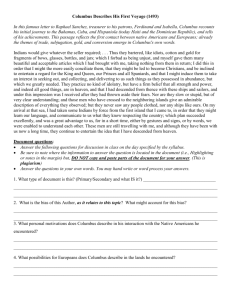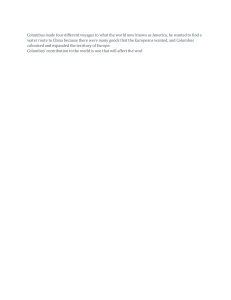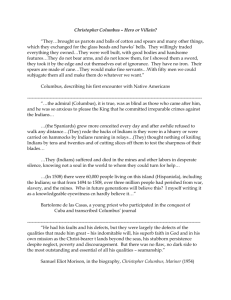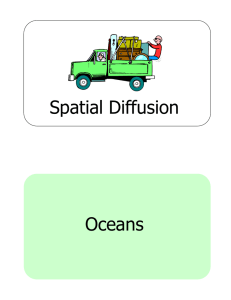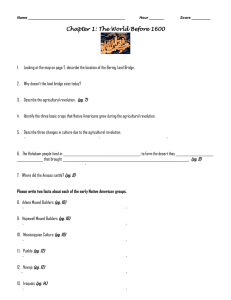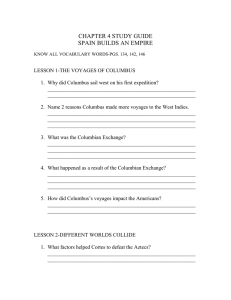Columbian Exchange DBQ: Historical Analysis & Source Evaluation
advertisement
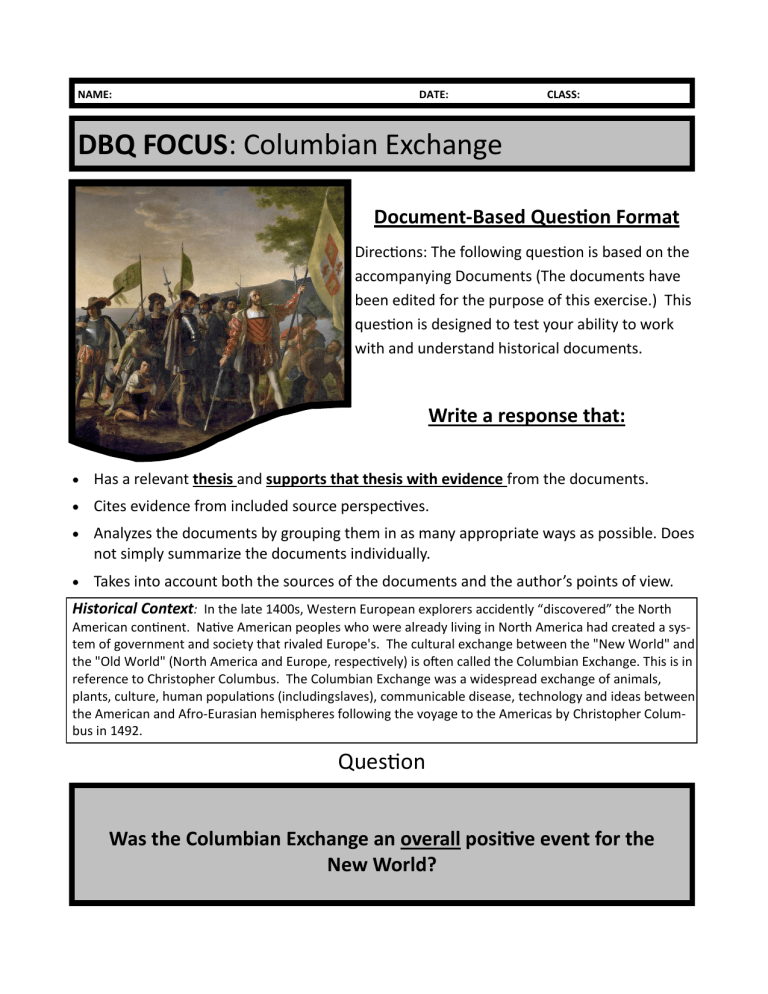
NAME: DATE: CLASS: DBQ FOCUS: Columbian Exchange Document-Based Question Format Directions: The following question is based on the accompanying Documents (The documents have been edited for the purpose of this exercise.) This question is designed to test your ability to work with and understand historical documents. Write a response that: Has a relevant thesis and supports that thesis with evidence from the documents. Cites evidence from included source perspectives. Analyzes the documents by grouping them in as many appropriate ways as possible. Does not simply summarize the documents individually. Takes into account both the sources of the documents and the author’s points of view. Historical Context: In the late 1400s, Western European explorers accidently “discovered” the North American continent. Native American peoples who were already living in North America had created a system of government and society that rivaled Europe's. The cultural exchange between the "New World" and the "Old World" (North America and Europe, respectively) is often called the Columbian Exchange. This is in reference to Christopher Columbus. The Columbian Exchange was a widespread exchange of animals, plants, culture, human populations (includingslaves), communicable disease, technology and ideas between the American and Afro-Eurasian hemispheres following the voyage to the Americas by Christopher Columbus in 1492. Question Was the Columbian Exchange an overall positive event for the New World? Document 1 Source: Christopher Columbus, describing his first encounter with the native Arawak men and women. “They…brought us parrots and balls of cotton and spears and many other things, which they exchanged for the glass beads and hawks’ bells. They willingly traded everything they owned…They were well built, with good bodies and handsome features…They do not bear arms, and do not know them, for I showed them a sword, they took it by the edge and cut themselves out of ignorance. They have no iron. Their spears are made of cane…They would make fine servants…With fifty men we could subjugate them all and make them do whatever we want.” Student Analysis How does Christopher Columbus view the native populations he initially encounters? Document 2 Source: Bartolome de las Casas, a young priest who participated in the conquest of Cuba and transcribed Columbus’ journal …(the Spaniards) grew more conceited every day and after awhile refused to walk any distance…(They) rode the backs of Indians is they were in a hurry or were carried on hammocks by Indians running in relays…(They) thought nothing of knifing Indians by tens and twenties and of cutting slices off them to test the sharpness of their blades… Student Analysis The native islanders were viewed as an inferior nation of people whom could be exploited. Describe the impact and the treatment of the native islanders by the Europeans. …They (Indians) suffered and died in the mines and other labors in desperate silence, knowing not a soul in the world to whom they could turn for help… …(In 1508) there were 60,000 people living on this island (Hispaniola), including the Indians; so that from 1494 to 1508, over three million people had perished from war, slavery, and the mines. Who in future generations will believe this? I myself writing it as a knowledgeable eyewitness can hardly believe it…” Document 3 Source: Howard Zinn, A People’s History of the United States; 1492Present. Harper Collins Publisher, 2010. Pg. 7. Thus began the history, five hundred years ago, of the European invasion of the Indian settlements in the Americas. That beginning, when you read Las Casas-even if his figures are exaggerations (were there 3 million Indians to begin with, as he says, or less than a million, as some historians have calculated, or 8 million as others now believe?) is conquest, slavery, death. When we read the history books given to children in the United States, it all starts with heroic adventure-there is no bloodshed-and Columbus Day is a celebration. Student Analysis According to Zinn, how is history presenting an inaccurate representation of the cultural encounter between Columbus and the Arawaks? Document 4 Source: Bartolome de las Casas, a young priest who participated in the conquest of Cuba and transcribed Columbus’ journal Thus husbands and wives were together only once every eight or ten months and when they met they were so exhausted and depressed on both sides . . . they ceased to procreate. As for the newly born, they died early because their mothers, overworked and famished, had no milk to nurse them, and for this reason, while I was in Cuba, 7000 children died in three months. Some mothers even drowned their babies from sheer desperation.... In this way, husbands died in the mines, wives died at work, and children died from lack of milk . . . and in a short time this land which was so great, so powerful and fertile ... was depopulated.... My eyes have seen these acts so foreign to human nature, and now I tremble as I write...." Student Analysis Describe the demographic (population) changes that occur as a result of the arrival of Columbus. Document 5 Source: Kenneth Auchincloss, When Worlds Collide Newsweek Fall/Winter 1991. Above all, it leaves out the fact that this encounter was inevitable. This is not simply to state the obvious: that if Columbus hadn't set sail in 1492, some other European voyager would have made the trip soon afterward. The key point is that whoever made the first crossing and whenever it occurred, the consequences for the people of the Western Hemisphere would not have been much different. To expect otherwise is to ask that history be rolled back long before 1492 and that its course be plotted along other lines entirely. In particular, European civilization would have to be recast. What drove Columbus westward was not just a search for a lucrative new trade route to Asia. It is too simplistic to picture him and the other European explorers as mere money- grubbers, early real-estate developers who lucked into an entire continent to subdivide. Money was obviously important to them, but they were also animated by a certain restlessness and curiosity. The voyage into the unknown, after all, had been part of European culture since the days of Odysseus. To some degree this questing instinct was bound up with religious zeal: look, for example, at the search for the Holy Grail and the history of the Crusades. On a more mundane level, it was often a social necessity: families were large, houses were small, land was scarce, and so young people were encouraged to leave home and seek their fortune. Missionaries set out to preach the Gospel. Merchants set out to find new goods and new markets to sell them in. Armies sometimes led this process, sometimes followed. The spread of Western civilization was built on intrusion. Student Analysis If Columbus hadn’t incidentally “discovered” the New World would world history be substantially different? Why did the Europeans seek to explore distant points on the planet? Document 6 Source: “The Crimes of Christopher Columbus” Dinesh D'Souza The charge of genocide is largely sustained by figures showing the precipitous decline of the Indian population. Although scholars debate the exact numbers, in Alvin Josephy's estimate, the Indian population fell from between fifteen and twenty million when the white man first arrived to a fraction of that 150 years later. Undoubtedly the Indians perished in great numbers. Yet although European enslavement of Indians and the Spanish forced labor system extracted a heavy toll in lives, the vast majority of Indian casualties occurred not as a result of hard labor or deliberate destruction but because of contagious diseases that the Europeans transmitted to the Indians. Student Analysis How did disease have a greater impact on the native cultures of the New World than war or commerce? The spread of infection and unhealthy patterns of behavior was also reciprocal. From the Indians the Europeans contracted syphilis. The Indians also taught the white man about tobacco and cocaine, which would extract an incalculable human toll over the next several centuries. The Europeans, for their part, gave the Indians measles and smallpox. (Recent research has shown that tuberculosis predated the European arrival in the new world.) Since the Indians had not developed any resistance or immunity to these unfamiliar ailments, they perished in catastrophic numbers. Document 7 Source: “The Great Disease Migration” Geoffrey Cowley, in Newsweek Fall 1991 The disaster began almost as soon as Columbus arrived, fueled mainly by smallpox and measles. Smallpox--the disease that so ravaged Tenochtitlan on the eve of Cortes's final siege-- was a particularly efficient killer. Alfred Crosby, author of "The Columbian Exchange," likens its effect on American history to "that of the Black Death on the history of the Old World." Smallpox made its American debut in 1519, when it struck the Caribbean island of Santo Domingo, killing up to half of the indigenous population. From there outbreaks spread across the Antilles islands, onto the Mexican mainland, through the Isthmus of Panama and into South America. The Spaniards were moving in the same direction, but their diseases often outpaced them. "Such is the communicability of smallpox and the other eruptive fevers," Crosby notes, "that any Indian who received news of the Spaniards could also have easily received the infection." Student Analysis Explain what is meant by the statement “...any Indian who received news of the Spaniards could have also have easily received the infection.” Document 8 Source: World History Textbook, Map that illustrates the commodities traded during the Columbian Exchange. McDougal Little, 2007. Pg. 572. Student Analysis How was the agricultural aspect of the Columbian Exchange both beneficial and harmful to their relative populations? Document 9 Source: “Columbian Exchange” March 31, 2006 Lauren Rees. Exchanging crops proved to be a far more intricate, involved process than ever could have been imagined at the time. Remarkably, the people of the Americas realized that crops with higher caloric value could not only feed more people, but also allowed people to work harder because they were more energized. This led to an adoption of American crops by European peasantries that changed entire cuisines in various cultures and spread rapidly through the Americas, Europe and finally, Africa. An important crop in Europe was potatoes, as they could be left in the ground until they were ready to be eaten and allowed many Europeans to evade taxes, as tax collectors did not go so far as to dig up not yet harvested crops. Similarly, potatoes were also a helpful crop and food source because when armies invaded and rounded up food for themselves, they were similarly unable to steal the potatoes; thereby, leaving food for the European people. Animals were also a key part of the Columbian Exchange. Horses, pigs, sheep, and cattle were all European animals that flourished rapidly in the Americas because they were able to reproduce without being hindered by predators. Pigs were also a key animal used during ocean travels because they could be dumped on the way to a country or place and then picked up and eaten on the way back. The horse, too, was also a very useful animal as it helped with battle; it allowed for faster travel, it allowed for the surprising of opponents, and allowed people to fight from a higher level. Student Analysis How were ‘New World’ crops advantageous towards European society? What impact did ‘Old World’ animals have on the Americas?
